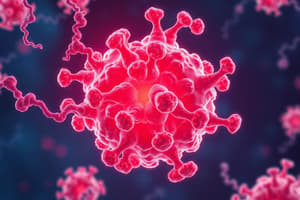Podcast
Questions and Answers
What is the primary mechanism of coupling in enzyme catalysis?
What is the primary mechanism of coupling in enzyme catalysis?
- Phosphate transfer from ATP to one of the substrates (correct)
- Denaturation of the enzyme to increase activity
- Hydrolysis of ATP to release energy
- Redox reactions to generate energy
Which of the following is NOT a method of enzyme regulation?
Which of the following is NOT a method of enzyme regulation?
- Allosteric inhibition
- Gene expression (correct)
- Phosphorylation
- Denaturation
What is the result of the drop in free energy during a chemical reaction?
What is the result of the drop in free energy during a chemical reaction?
- The reaction rate increases
- The reaction rate decreases
- The reaction becomes less favourable
- The reaction becomes more favourable (correct)
Which of the following is an example of posttranslational modification?
Which of the following is an example of posttranslational modification?
What is the function of DNA polymerase?
What is the function of DNA polymerase?
Which of the following is NOT an enzyme that creates a large molecular machine for carrying out complex tasks?
Which of the following is NOT an enzyme that creates a large molecular machine for carrying out complex tasks?
What is the purpose of enzyme regulation?
What is the purpose of enzyme regulation?
Which of the following is an example of supramolecular complex?
Which of the following is an example of supramolecular complex?
What is the role of phosphorylation in enzyme regulation?
What is the role of phosphorylation in enzyme regulation?
Which of the following is NOT a type of posttranslational modification?
Which of the following is NOT a type of posttranslational modification?
Flashcards are hidden until you start studying
Study Notes
Protein Therapeutics
- Proteins can be developed and produced to serve specific therapeutic functions, such as treating metabolic disorders, resisting infections, and arresting the spread of cancer.
- Protein-based drugs can be grouped into four categories based on their pharmacological activity:
- Group 1: therapeutics with enzymatic or regulatory activity
- Group 2: therapeutics with special targeting activity
- Group 3: vaccines
- Group 4: diagnostic agents
- Protein therapeutics have several advantages over small-molecule drugs, including:
- highly specific and complex functions that cannot be mimicked by simple chemical compounds
- less potential for interference with normal biological processes and adverse effects
- well-tolerated and less likely to elicit immune responses
- effective replacement treatment for diseases with mutated or deleted genes
- faster clinical development and FDA approval time
- unique form and function, allowing for far-reaching patent protection
- The first recombinant protein used in therapy was insulin, which was purified from bovine pancreas in 1922 and later produced through genetic engineering in E. coli bacteria in 1978.
Challenges of Recombinant Proteins
- Storage, distribution, and understanding of protein properties (solubility, ability to enter the body, stability)
- Degradation of proteins through lysosome, proteosome, or protease action
- Immune response, which can neutralize the effect of the introduced protein or cause severe effects
- Administration of active protein/enzyme in active conformation, considering post-translational modifications
- Cost and time-consuming process of producing recombinant proteins
- Ethical issues in investing in research for rare diseases versus widely distributed diseases
Enzymatic Catalysis
- Enzymes are biological catalysts made of proteins that accelerate chemical reactions without heating.
- Enzymes are:
- efficient, with acceleration rates of up to 17 orders of magnitude
- substrate-specific, with active sites that complement the substrate geometrically and electrostatically
- reaction-specific, catalyzing a single reaction
- There are six classes of enzymes:
- Oxidation-reduction class (catalyzes oxidoreduction reaction)
- Group transfer class (catalyzes transfer of a chemical group from one molecule to another)
- Hydrolysis class (catalyzes reaction in which a molecule is broken down using a water molecule)
- Water-independent lysis class (catalyzes reaction hydrolysis of a molecule without a water molecule)
- Isomerisation class (catalyzes isomerization of a chemical group or double bond)
- Ligation class (catalyzes binding of two molecules, often coupled with energy consumption by hydrolysing ATP)
- Enzymes can be classified using the Enzyme Classification (E.C) system, which assigns a 4-digit number indicating the class, reaction, and specific information.
- Enzymes can:
- couple energy-demanding reactions to ATP hydrolysis
- be regulated through means such as small molecules, phosphorylation, degradation, synthesis, and post-translational modifications
- create large molecular machines for carrying out complex tasks
Studying That Suits You
Use AI to generate personalized quizzes and flashcards to suit your learning preferences.




